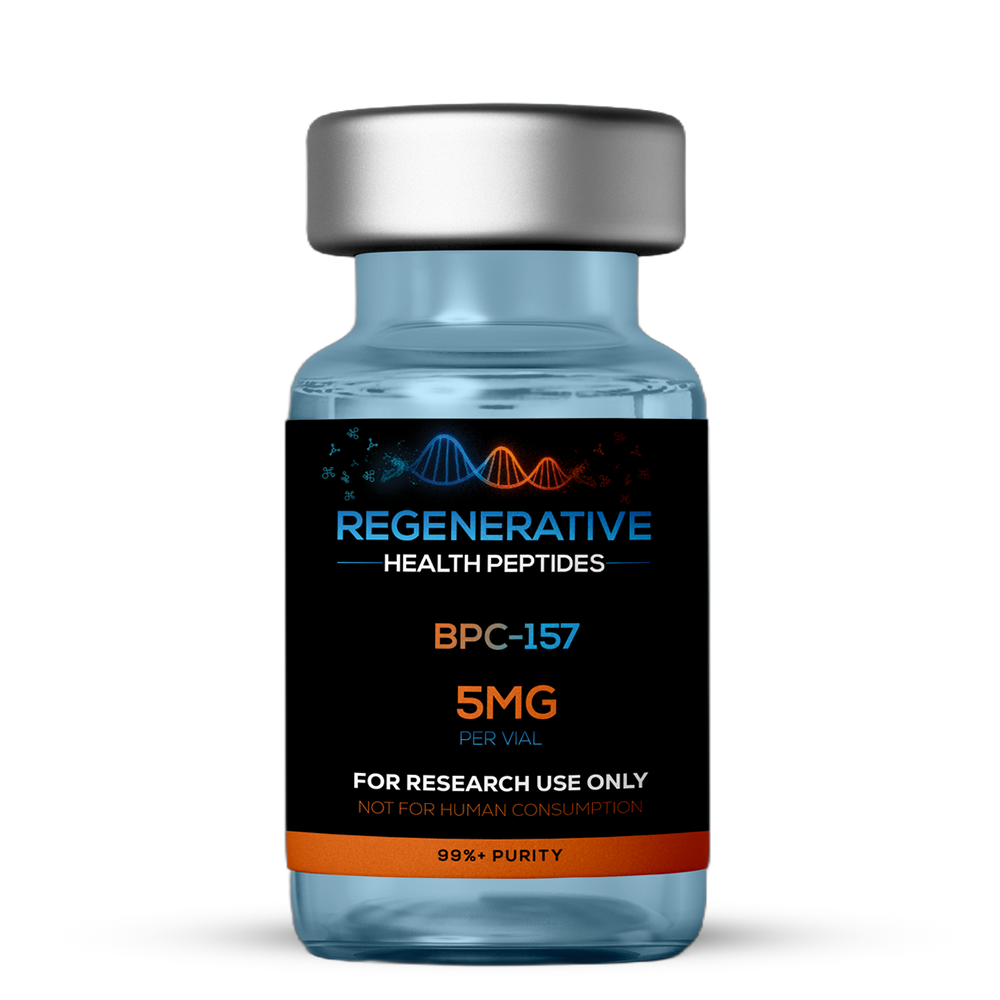BPC-157 (5mg)
$102.00
BPC-157 (5 mg) is a research-grade pentadecapeptide renowned for its broad regenerative potential. Every batch is tested for purity, identity, and professionally labeled in the USA by Regenerative Health Peptides before being supplied strictly for in-vitro investigations. This BPC-157 research peptide—not for human or animal use—enables scientists studying musculoskeletal, neurological, and gastrointestinal repair pathways while sourcing trusted American research peptides through a leading US peptide store.
Overview
BPC-157 is a stable gastric pentadecapeptide derived from a protective protein found in human gastric juice. The peptide has garnered attention in research settings for its role in promoting systemic tissue regeneration and protecting against inflammatory and oxidative damage. Its resistance to enzymatic degradation in acidic environments makes it well-suited for diverse laboratory investigations.
BPC-157 Peptide Structure
- Sequence: Gly-Glu-Pro-Pro-Pro-Gly-Lys-Pro-Ala-Asp-Asp-Ala-Gly-Leu-Val
- Molecular Formula: C62H98N16O22
- Molecular Weight: 1419.5 g/mol
- PubChem CID: 108101
Mechanisms of Action
Researchers specializing in regenerative therapies have identified that BPC-157 interacts with various biological pathways, including nitric oxide modulation, VEGFR2 signaling, angiogenesis, and the upregulation of growth hormone receptors. These activities suggest its potential utility in a broad spectrum of investigative domains, from cellular repair to inflammation regulation and vascular remodeling.
Research Areas:
- Tissue Regeneration & Wound Healing Studies show that BPC-157 accelerates epithelial and connective tissue repair through enhanced fibroblast activity and growth factor expression.[1][2][3]
- Tendon, Ligament & Muscle Recovery Preclinical research supports its role in tendon reattachment, muscle fiber healing, and improving biomechanical strength in soft tissue injury models.[4][5][6]
- Gastrointestinal and Liver Support BPC-157 has demonstrated gastroprotective effects against NSAID-induced damage, ulcers, colitis, and intestinal permeability in rodent models.[7][8][9][11]
- Neurological Regeneration Findings suggest it enhances nerve regeneration, stabilizes the blood-brain barrier, and mitigates neuroinflammation through modulation of oxidative stress pathways.[10][11]
- Vascular Healing & Angiogenesis The peptide facilitates angiogenesis, supports endothelial integrity, and has shown efficacy in ischemic wound and blood flow models.[12][13]
- Anti-Inflammatory and Cytoprotective Effects In-vitro studies indicate it may reduce systemic inflammation markers while preserving cellular integrity in response to toxins or oxidative insult.[6][10]
Product Usage:
This product is strictly intended for research use only. It is not intended for human or veterinary use. BPC-157 (5mg) is formulated exclusively for in-vitro applications, which are performed outside the living body (Latin: in glass). The product has not been evaluated by the FDA and must not be used for the treatment, diagnosis, or prevention of any disease.
Disclaimer
All products and content presented on this website are intended exclusively for research and educational purposes only. The compounds available are for in-vitro studies only and are not for human or animal use. These products have not been approved by the FDA to treat, diagnose, or cure any condition.
BPC-157’s research applications span several regenerative, neurological, and metabolic domains:
- Muscle and Tendon Healing: Enhances tendon-to-bone healing and supports ligament and muscle regeneration.[4][5]
- Intestinal Integrity: Demonstrates significant healing in models of IBD, colitis, intestinal ulcers, and gastrointestinal lesions.[7][8][11]
- Neurological Benefits: Preserves neuronal pathways, accelerates functional nerve recovery, and stabilizes the blood-brain barrier post-trauma.[10]
- Angiogenesis and Vascular Support: Upregulates VEGFR2 and increases microvessel density in injured tissue sites.[12][13]
- Gastroprotective Mechanisms: Counters NSAID-induced lesions, improves endothelial function, and promotes nitric oxide synthesis.[3][7]
- Potential Metabolic and Weight Loss Research: Early studies show improved energy metabolism, vascular recovery, and inflammation reduction, making it promising in weight management investigations.[13]
References:
- Seiwerth et al. Journal of Physiology-Paris, 91, 173–178.
- Huang et al. Drug Design, Development and Therapy, 9, 2485–2499.
- Šola et al. FASEB Journal, 36.
- Chang et al. Journal of Applied Physiology, 110, 774–780.
- Chang et al. Molecules, 19(11), 19066–19077.
- Japjec et al. Biomedicines.
- Drmic et al. World Journal Gastroenterology, 24(48), 5462–5476.
- Duzel et al. World Journal Gastroenterology, 23(48), 8465–8488.
- Vukojević et al. Vascular Pharmacology, 106, 54–66.
- Hsieh et al. Journal of Molecular Medicine, 95(3), 323–333.
- Sikiric et al. PMCID: PMC6271067.
- Examine.com. BPC-157 Research Summary.
- RupaHealth. Science-backed BPC-157 Guide
BPC-157 (5mg) is delivered as a lyophilized (freeze-dried) peptide to maximize shelf stability and maintain purity.
- Unreconstituted Peptide Storage: Store at -20°C in a dark, dry environment. Under these conditions, peptides remain stable for up to 3–4 months.
- After Reconstitution: Once mixed with bacteriostatic water, store at 4°C and use within 30 days.
- Long-Term Storage: For research that requires extended storage beyond 30 days, freeze at -80°C. Avoid multiple freeze-thaw cycles to maintain peptide activity and structure.
Proper storage conditions ensure optimal performance and help preserve research-grade quality for all investigative applications.
